A Rift in the Earth
Is Maya Lin’s celebrated Vietnam Veterans Memorial really a work of architecture?
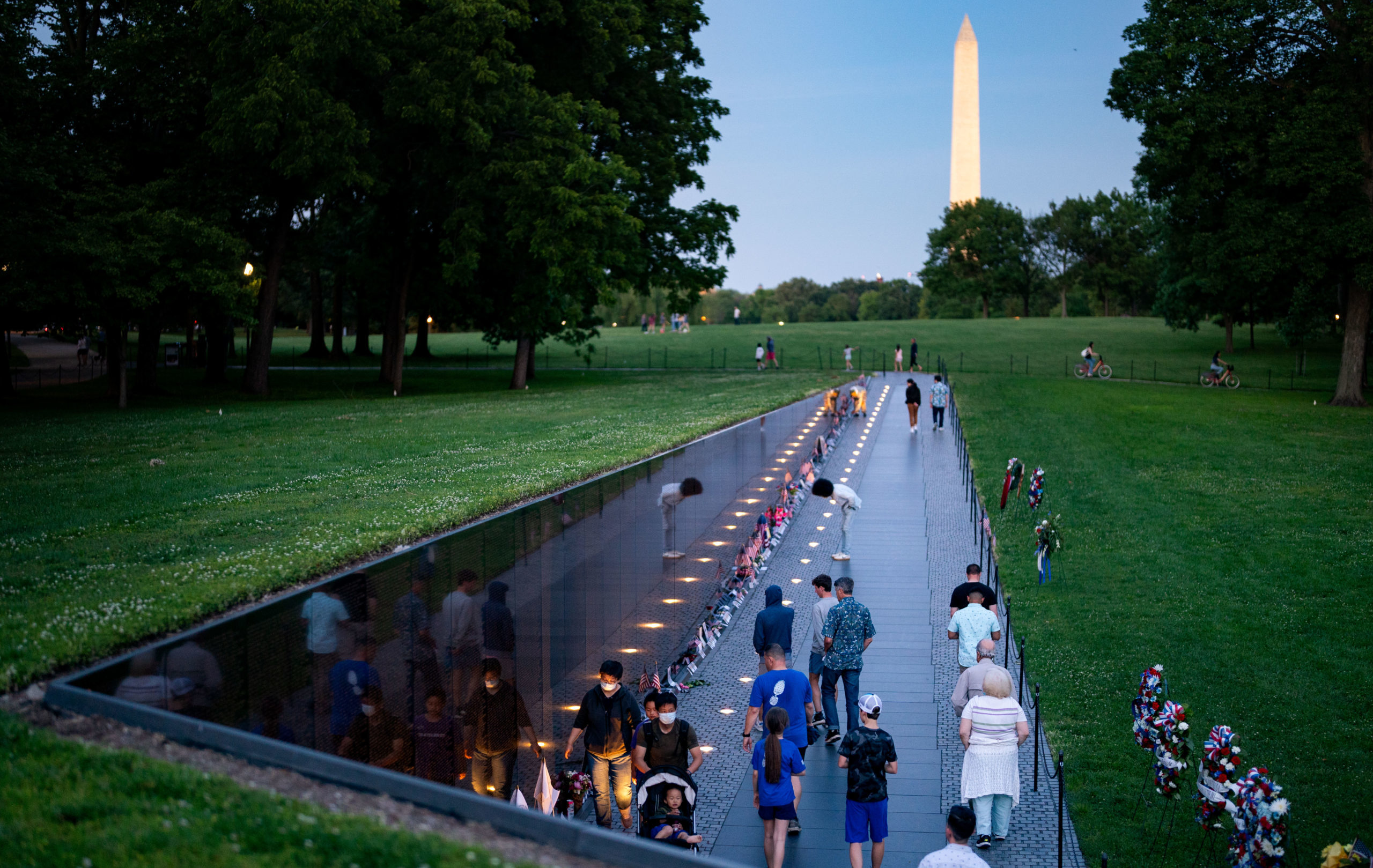
In 2007, the American Institute of Architects publicized the results of a poll ranking Americans’ favorite architecture. The only modernist work to make the top ten was the Vietnam Veterans Memorial on Washington’s National Mall. (It ranked tenth, behind the White House, U.S. Capitol, and Jefferson and Lincoln Memorials.) But is Maya Lin’s celebrated chevron-shaped memorial, dedicated to widespread public acclaim 40 years ago last month, really a work of architecture?
Lin’s chevron is a retaining wall embedded in the gently rolling landscape of the Mall’s Constitution Gardens. It bears the names of over 58,000 Americans who lost their lives in Vietnam. In the statement accompanying her winning 1981 competition entry, one of 1,421 submitted, the Yale undergraduate described her design concept as “a rift in the earth—a long, polished black stone wall, emerging from and receding into the earth.” A “rift in the earth” is a negative form. You don’t make architecture with negative forms. While Lin’s wall qualifies as landscape architecture, it would be a real stretch to regard it as architecture tout court.
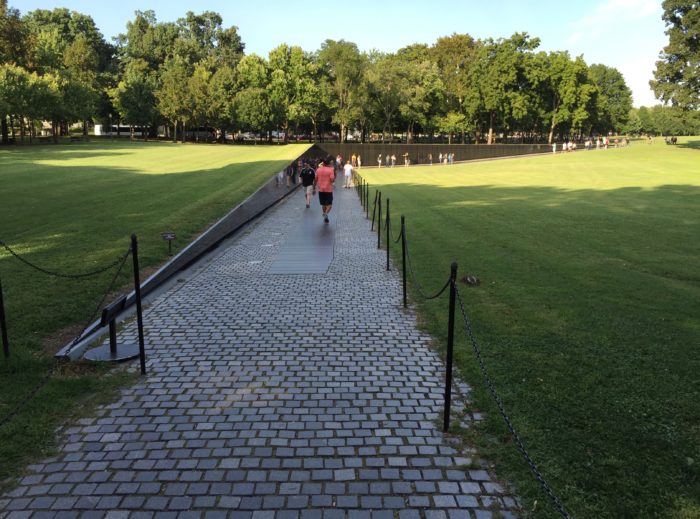
Credit: Catesby Leigh
In the spirit of holiday cheer and goodwill, however, we’ll pass over the question of whether the bright lights at the AIA know what architecture is.
The chevron’s wings, each 247 feet long, extend at a 125 degree angle from a vertex 10 feet high that serves as the memorial’s focal point. The wings taper off toward each end, pointing toward the Lincoln Memorial and Washington Monument, respectively. Each consists of seventy reflective granite panels with the names inscribed in the chronological order in which servicemen (only eight women are listed) lost their lives or went missing. Visitors descend alongside the wall, on a gentle incline, to the vertex, where the names begin and end.
There is another angle on appraising the Vietnam memorial wall as architecture. Until the 1930s, this “mistress art” was generally assumed to revolve around the decoration of construction: more specifically, as I noted in a post earlier in the year, the humanistic transfiguration or idealization of structure in order to create buildings worthy of their civic purposes. The arrangement of dominant and subordinate masses in a manner analogous to the structure of the human body and the more or less ornamental elaboration of various components—doorways, windows, cornices, and so on—served to endow them with a legible human scale. Sculpture, whether in relief or in the round, could enhance their symbolic import as well as their beauty. Distinct architectural styles, typically sharing origins in the classical canon, were employed to make the different elements of a design harmonize to produce an aesthetically resonant whole.
Want more of the best conservative thought? Support TAC today!
This traditional concept of architecture was manifestly irrelevant to the design of Lin’s wall, the most popular example of minimalist design the world has ever seen. True, the Vietnam memorial is situated adjacent to the classical outlier that is the Washington Monument, a soaring granite obelisk that is equally devoid of ornament. But that monument is a positive form that is recognizably a variation on an ancient architectural type. And it complements the other luminous classical structures within Washington’s monumental core, starting with the Capitol and Lincoln Memorial at each end of the Mall. In stark contrast, Lin’s wall is a dark, chthonic form. Around the time of its dedication, the celebrated Life photographer David Douglas Duncan pronounced it “a formalized mass grave.”
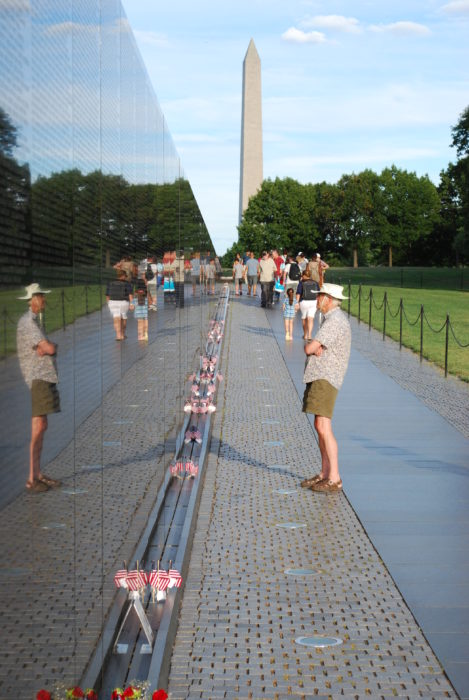
Credit: Catesby Leigh
Through their idealization of structure, the many classical buildings that make a powerful impression on visitors to our nation’s capital embody a communitarian ethos, by analogy with the nation’s own aspiration to forge a more perfect union, that transforms the “is” of mere construction into the “ought” of architecture. In other words, classical architecture addresses the public as a community. That is what the Vietnam memorial does not do. It is quintessentially the fruit of modernity, whose founding dynamic is to be found, as Philip Rieff observed over half a century ago in The Triumph of the Therapeutic, in “the destruction of all idealizations upon which traditional and classical communities were based, in theory and practice.”
According to Lin’s competition statement, once confronted with the multitude of names on the memorial wall and
[b]rought to a sharp awareness of such a loss, it is up to each individual to resolve or come to terms with this loss. For death is in the end a personal and private matter, and the area contained within this memorial is a quiet place meant for personal reflection and private reckoning.
A monument, of course, is not a place. It is a structure. The Vietnam memorial—as I noted in a recent commentary concerning the new Memorial to Enslaved Laborers at the University of Virginia, which owes a significant conceptual debt to Lin’s creation—is an anti-monument. It addresses us not as members of a community whose welfare depends on the courage and self-sacrifice of its martial defenders, but as atomized, even traumatized selves. In a way Lin could not possibly have anticipated, it emerged as a major harbinger of the therapeutic culture that has tended to undermine the idea of virtue as the indispensable pillar supporting civilized life.
Significantly, the idea for the memorial originated with Jan Scruggs, a Vietnam combat veteran whose graduate studies in PTSD nurtured his immersion in the therapeutic culture. He wholeheartedly embraced its rhetoric of “healing,” and his memoir of the memorial project is entitled To Heal a Nation. Yet his original idea of the memorial as including both the names of the dead as well as statuary paying tribute to the veterans’ valor was a cultural hybrid. And in the event, that idea was realized in a very roundabout way.
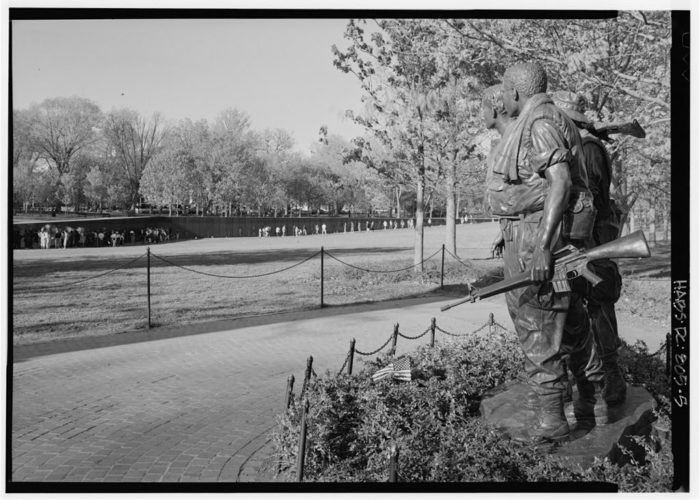
Credit: Historic American Buildings Survey, Library of Congress Prints and Photographs Division
A military memorial that is about “loss” is a victim’s memorial, not a hero’s monument. And this is why The Wall, as the Vietnam Veterans Memorial Foundation Scruggs co-founded refers to it, caused so much resentment—especially among service academy graduates like James Webb, the decorated Marine, respected author, and then-future U.S. senator. That resentment and the political furor it incited led to the addition, two years after The Wall’s dedication, of sculptor Frederick Hart’s Three Servicemen—bronze statues of three soldiers who appear to be emerging from a hazardous patrol. Their gaze is directed toward The Wall, situated some 40 yards away, as if they too were taking stock of the war’s toll.
But the cultural impact of Hart’s servicemen has been minor compared to that of Lin’s wall. And it’s important to note that the latter’s impact does not make for simple political breakdowns. One of the strongest, most articulate advocates of Lin’s design was James J. Kilpatrick, the conservative columnist whose sparring matches with Newsweek’s Shana Alexander, as older readers will recall, were once a regular 60 Minutes feature. “On this sunny Friday morning,” he wrote not long before the memorial’s dedication, “the black walls mirrored the clouds of a summer’s ending and reflected the leaves of an autumn’s beginning, and the names—the names!—were etched enduringly upon the sky.”
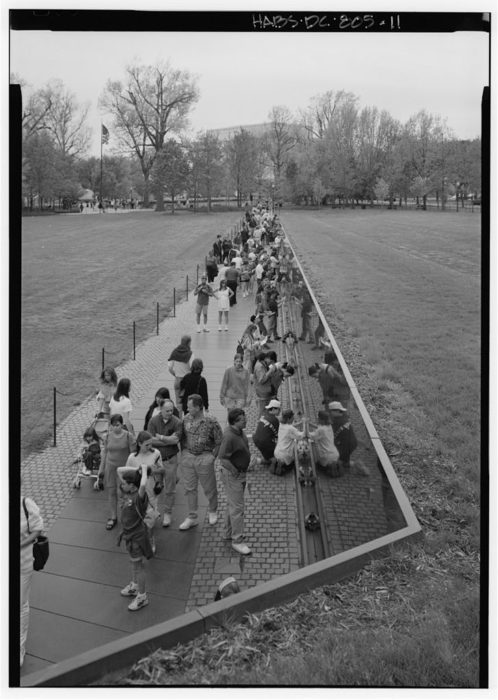
Credit: Historic American Buildings Survey, Library of Congress Prints and Photographs Division
And yet the qualities Kilpatrick praised so highly are, in terms of artistic achievement, themselves rather minimal. In other words, they are essentially conceptual. Another problem is that the The Wall has proved a one-off. Numerous memorial designers over the last four decades have aspired to be the next Maya Lin, but none has hit pay dirt. A minimalist formal vocabulary filled out with nothing more than names and timelines or other rudimentary factual data is extremely unlikely to yield an aesthetically resonant and emotionally meaningful result. So other ingredients have to be added to the recipe, one of the more expensive being “education centers” or themed museums. Think of the museological facilities at the 9/11 memorial at Ground Zero in Manhattan (2014)—whose main feature, the two watery abysses marking the footprints of the destroyed Twin Towers, are themselves negative forms—or the Oklahoma City National Memorial (2001).
Subscribe Today
Get daily emails in your inbox
Names can lose resonance over time, and Scruggs accordingly began campaigning for an underground, 35,000-square-foot Education Center at The Wall two decades ago. Eventually budgeted at around $125 million, the center was to include a Wall of Faces with photographs of the people named on The Wall, a sampling of mementoes left there, and timelines of the Vietnam War and the memorial project itself. Fortunately, the fundraising effort came up short and plans for the center were scrapped in 2018.
It is hardly uncommon for memorials to lose their hold on the public imagination as the events they mark recede into the mists of time. And when it comes to The Wall, the enormous sensation it caused could not last forever. Three decades ago, as I noted in my critique of the Enslaved Laborers Memorial, the Vietnam memorial was attracting more visitors than the Lincoln. In 2021, it got fewer than two-thirds as many. But however large or small the public it attracts in the years to come, Maya Lin’s creation will offer valuable, if not terribly heartening, insights into our culture.
This New Urbanism series is supported by the Richard H. Driehaus Foundation. Follow New Urbs on Twitter for a feed dedicated to TAC’s coverage of cities, urbanism, and place.